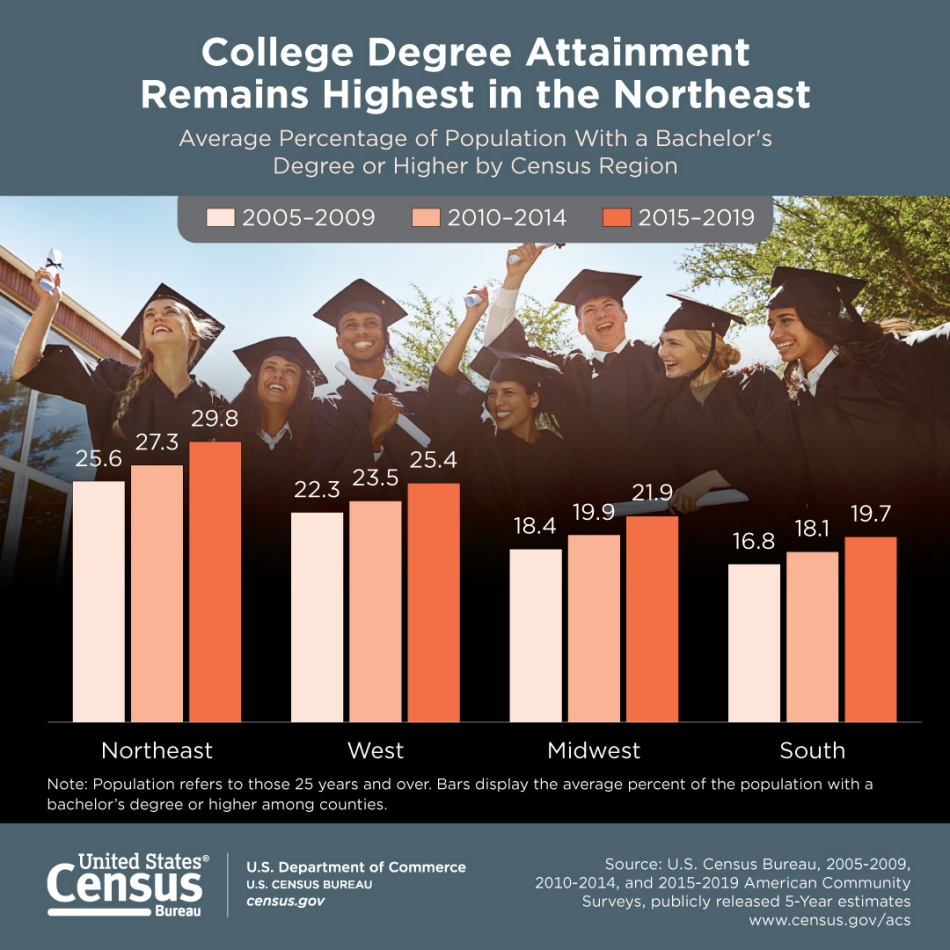Washington, DC…The U.S. Census Bureau announced the release of a new report that examines characteristics of the U.S. population with bachelor’s degrees. The report, Bachelor’s Degree Attainment in the United States: 2005 to 2019, is based on statistics from the American Community Survey (ACS). Since 2010, the ACS has published estimates based on five years of data for geographic areas down to the census tract and block-group levels. For the first time ever, these estimates are available for three consecutive, nonoverlapping periods (2005-2009, 2010-2014, and 2015-2019), providing trend data for small population groups and geographies covering a combined 15-year period.
Bachelor’s degrees are important markers of progress for both individuals and society. People with a bachelor’s degree typically have higher lifetime earnings, lower odds of unemployment, and better health outcomes than those without one. The report presents findings for all race groups and national and county-level changes in bachelor’s degree attainment in the United States from 2005-2009 to 2015-2019.
Highlights include:
- The percentage of the population 25 years and over with a bachelor’s degree or higher increased by about 1.8 percentage points between 2005-2009 and 2010-2014, and 2.8 percentage points between 2010-2014 and 2015-2019.
- From 2005-2009 to 2015-2019, the percentage of people with a bachelor’s degree increased for all race groups. For 2015-2019, Asian alone had the highest rate of bachelor’s degree attainment (54.3%), followed by White alone, non-Hispanics.
- 57.7% of counties in the United States saw increases in the percentage of people with bachelor’s degrees from 2005-2009 to 2015-2019.
- Counties in the Northeast region of the United States had a higher percentage of people with bachelor’s degrees than all other regions in the country for 2015-2019 as well as the highest percentage point increase in bachelor’s degree attainment from 2005-2009 to 2015-2019 among census regions.
Detailed tabulations, related information and historic data are available on the Census Bureau’s Educational Attainment page at < www.census.gov/topics/education/educational-attainment.html>.
The ACS is a nationwide survey designed to provide timely and reliable data every year on the demographic, social, economic and housing characteristics of the nation, states, counties and other localities. The survey has an annual sample size of about 3.5 million addresses across the United States and Puerto Rico, and includes housing units and group quarters. The ACS is conducted in every county in the nation. The ACS 1-year estimates are released for geographic areas with populations of 65,000 or greater. The ACS 5-year estimates are released for all geographic areas. For information on the ACS sample design and other topics, visit <www.census.gov/programs-surveys/acs/>.
Data in this report are subject to sampling and nonsampling error. Comparisons of estimates take sampling error into account and are significant at the 90% confidence level or higher, unless otherwise noted. Because of rounding, some details may not sum to totals. For information on sampling and estimation methods, confidentiality protection, and sampling/nonsampling errors, see the Accuracy of the Data documents for 2019.



